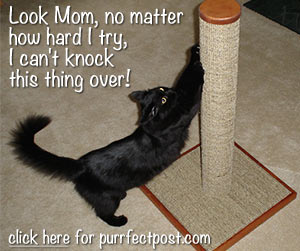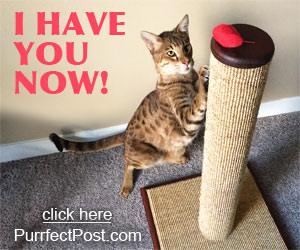Should Cats Be Fed Meals or Free Choice?

Cats make great pets for many reasons. One of these is that they are fairly easy to care for. Many people love the fact that they don't have to take their cat outside to eliminate and can leave food down all the time. These perks mean owners don't have to be as tied to being home at particular times as they might be with a dog.
But is feeding a cat free choice like that the best idea for his health? Could meal feeding be healthier?
Indoor Cats Are Prone to Obesity
Indoor cats don't always get as much exercise as they should; they don't have to expend lots of calories hunting for their food, and they have more of a tendency to become overweight than cats that go outside. Being inside is safest for cats, but obesity is linked to many feline illnesses, so it's crucial that we find ways to keep their weight normal.
When a cat is fed free choice, where the food is kept down all the time, there is not much control over how much the cat eats. People usually just fill the bowl again when it's empty and may not pay attention to how often that occurs. When there are multiple cats in the household and free feeding is the method used, people usually have no idea how much each cat eats. That means that some cats may become overweight while others might actually not get enough food. Dominant cats might guard the food bowl and more timid cats could find it hard to get to it. Meal feeding is a great way to be able to control how much food each cat in your home receives.
The Earliest Sign of Many Illnesses Might Be Missed with Free Feeding
When a cat has food down all the time, it can be difficult for an owner to notice right away if the kitty's appetite is drastically reduced or gone. It can take a couple of days for the person to realize that they aren't having to fill the bowl as often. In the case of multiple cat households, this is even more pronounced. Because decreased or absent appetite is the first sign of many feline illnesses, not noticing it can be dangerous.
Note: If you have one cat that seems to self-regulate well, isn't gaining any weight over time, and you feel confident about monitoring her appetite, there is no need to change her from free choice to meal feeding unless you want to.
Cats Can Be Gluttonous
Wild cats often go short or long periods between meals; then they eat a lot all at once when they make a kill. Their indoor house cat descendents might have the innate urge to eat everything in front of them while it's there. That can cause problems like regurgitation of undigested food, becoming overweight, and developing insulin resistance that leads to diabetes mellitus.
Alternatives to Free Feeding
If you currently feed your cat free choice and want to switch to meals but don't want to lose the schedule flexibility that you currently enjoy, you can try one of the following:
- Use an auto feeder that will open at intervals and provide a pre-set amount of food to the cat.
- Use a puzzle feeder to put your cat's daily allocation of kibble into; your cat will need to work to get it out over time rather than be able to sit and eat it all at once.
-
Break your cat's daily kibble amount into several smaller amounts and hide it in multiple bowls around the house. Your cat will have to "hunt" to find them throughout the day.
Remember: water should always be free choice. Sources of clean, fresh water should be provided to your cat(s) at all times. A fountain can work well for this.
How to Switch Your Cat's Eating Plan to Meals
If your cat is currently free fed and you want to change to meals, here's what to do:
- Put out the first meal and make sure your cat sees it. After 30-60 minutes, pick it up.
- Don't put another meal down until the next scheduled time. After 30-60 minutes, pick it up.
Your cat will get used to this routine quite quickly and understand that the food will be available for short periods of time only. In between, if your cat begs for food, distract her with a wand toy game or play some fetch with a throw toy.
How to Use Meal Feeding in Multiple Cat Households
It can be tricky to do meal feeding in homes where there is more than one cat, but it can be even more crucial to do so because it's harder to monitor the appetites of individual cats with multiple cats eating out of the same bowls all day. Also, individual cats in the home might have medical conditions that require a special diet. Even if that isn't the case today, it could occur at any time, and if your cats are already used to meal feeding, it will be much easier for you to ensure that the one needing a strict diet gets it. Here's how you can implement meal feeding in your multiple cat household:
- Separate the cats before meal time. You might use different rooms with doors, or you may be able to get away with using separate areas of the same room if the cats aren't prone to fighting over food.
- Go back and feed each cat individually. Start with the most aggressive eater.
- Allow the cats 30-60 minutes to eat. If they are finished sooner, you can pick up their bowls and open the doors.
You can learn more here: "Tips for Feeding Cats in Multiple Cat Households."
Use Feliway to Keep Things Calm
Feliway, an analog of the feline calming pheromone, can help reduce the stress that switching from free choice feeding to meal feeding can cause the feline members of your household. You can diffuse it in the areas of the home where food bowls are kept.
You May Also Like These Articles:
Can Cats Be Vegetarians or Vegans?
Should You Get Your Cat a Water Fountain?
Ethoxyquin, Mercury, and PCBs: Is Feeding Fish Safe for Cats?
Wet Food vs. Dry Food For Cats
Notice: Ask-a-Vet is an affiliated service for those who wish to speak with a veterinary professional about their pet's specific condition. Initially, a bot will ask questions to determine the general nature of your concern. Then, you will be transferred to a human. There is a charge for the service if you choose to connect to a veterinarian. Ask-a-Vet is not manned by the staff or owners of CatHealth.com, and the advice given should not delay or replace a visit to your veterinarian.






